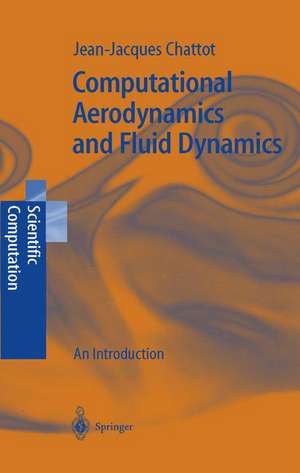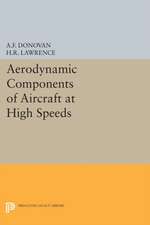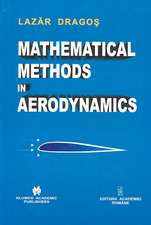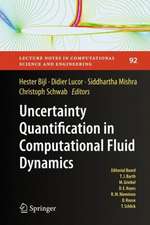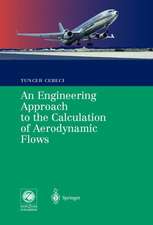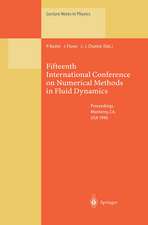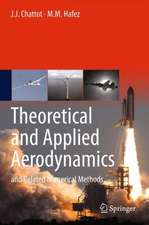Computational Aerodynamics and Fluid Dynamics: An Introduction: Scientific Computation
Autor Jean-Jacques Chattoten Limba Engleză Hardback – 7 aug 2002
| Toate formatele și edițiile | Preț | Express |
|---|---|---|
| Paperback (1) | 383.12 lei 43-57 zile | |
| Springer Berlin, Heidelberg – dec 2010 | 383.12 lei 43-57 zile | |
| Hardback (1) | 389.31 lei 43-57 zile | |
| Springer Berlin, Heidelberg – 7 aug 2002 | 389.31 lei 43-57 zile |
Din seria Scientific Computation
- 18%
 Preț: 1021.05 lei
Preț: 1021.05 lei - 18%
 Preț: 743.27 lei
Preț: 743.27 lei - 18%
 Preț: 889.75 lei
Preț: 889.75 lei - 18%
 Preț: 1108.51 lei
Preț: 1108.51 lei -
 Preț: 387.96 lei
Preț: 387.96 lei - 20%
 Preț: 902.04 lei
Preț: 902.04 lei -
 Preț: 400.85 lei
Preț: 400.85 lei -
 Preț: 386.61 lei
Preț: 386.61 lei - 15%
 Preț: 654.62 lei
Preț: 654.62 lei -
 Preț: 380.25 lei
Preț: 380.25 lei - 18%
 Preț: 1111.34 lei
Preț: 1111.34 lei -
 Preț: 452.62 lei
Preț: 452.62 lei - 18%
 Preț: 950.03 lei
Preț: 950.03 lei - 15%
 Preț: 649.22 lei
Preț: 649.22 lei - 18%
 Preț: 787.26 lei
Preț: 787.26 lei - 18%
 Preț: 942.63 lei
Preț: 942.63 lei - 15%
 Preț: 505.18 lei
Preț: 505.18 lei -
 Preț: 389.70 lei
Preț: 389.70 lei - 15%
 Preț: 653.00 lei
Preț: 653.00 lei - 18%
 Preț: 957.44 lei
Preț: 957.44 lei - 15%
 Preț: 653.98 lei
Preț: 653.98 lei - 15%
 Preț: 643.99 lei
Preț: 643.99 lei - 15%
 Preț: 649.39 lei
Preț: 649.39 lei -
 Preț: 388.13 lei
Preț: 388.13 lei - 18%
 Preț: 958.38 lei
Preț: 958.38 lei - 18%
 Preț: 1129.52 lei
Preț: 1129.52 lei - 18%
 Preț: 967.56 lei
Preț: 967.56 lei - 15%
 Preț: 700.75 lei
Preț: 700.75 lei -
 Preț: 401.03 lei
Preț: 401.03 lei - 15%
 Preț: 597.99 lei
Preț: 597.99 lei -
 Preț: 385.62 lei
Preț: 385.62 lei -
 Preț: 394.87 lei
Preț: 394.87 lei -
 Preț: 385.08 lei
Preț: 385.08 lei - 18%
 Preț: 1106.63 lei
Preț: 1106.63 lei - 15%
 Preț: 504.17 lei
Preț: 504.17 lei - 15%
 Preț: 596.36 lei
Preț: 596.36 lei - 15%
 Preț: 653.98 lei
Preț: 653.98 lei
Preț: 389.31 lei
Nou
Puncte Express: 584
Preț estimativ în valută:
74.52€ • 80.97$ • 62.64£
74.52€ • 80.97$ • 62.64£
Carte tipărită la comandă
Livrare economică 21 aprilie-05 mai
Preluare comenzi: 021 569.72.76
Specificații
ISBN-13: 9783540434948
ISBN-10: 3540434941
Pagini: 208
Ilustrații: XI, 194 p.
Dimensiuni: 155 x 235 x 17 mm
Greutate: 0.45 kg
Ediția:2002
Editura: Springer Berlin, Heidelberg
Colecția Springer
Seria Scientific Computation
Locul publicării:Berlin, Heidelberg, Germany
ISBN-10: 3540434941
Pagini: 208
Ilustrații: XI, 194 p.
Dimensiuni: 155 x 235 x 17 mm
Greutate: 0.45 kg
Ediția:2002
Editura: Springer Berlin, Heidelberg
Colecția Springer
Seria Scientific Computation
Locul publicării:Berlin, Heidelberg, Germany
Public țintă
GraduateCuprins
1. Introduction.- 2. Basics of the Finite-Difference Method.- 3. Application to the Integration of Ordinary Differential Equations.- 4. Partial Differential Equations.- 5. Integration of a Linear Hyperbolic Equation.- 6. Integration of a Linear Parabolic Equation.- 7. Integration of a Linear Elliptic Equation.- 8. Finite Difference Scheme for a Convection-Diffusion Equation.- 9. The Method of Murman and Cole.- 10. Treatment of Non-Linearities.- 11. Application to a System of Equations.- A. Problems.- B. Solutions to Problems.- References.
Recenzii
From the reviews:
"Most of the book is classical, i.e. the author carries out a clear and concise review of finite difference methods (explicit and implicit) used to integrate initial and/or boundary value problems for ordinary and partial differential equations. [...] However, it is the appendix devoted to problems, which confers a distinctive position on this book in the CFD literature. The author works out in detail ten nontrivial problems in a very pedagogical manner." (Zentralblatt MATH, 1013, 2003)
"[...] a very well-written book. This reviewer recommends it highly for advanced undergraduate and first-year graduate classes. In addition, engineers and scientists interested in numerical simulation of fluid flow and plasma flow should find this an excellent self-study textbook." (Shi Tsan Wu, Applied Mechanics Reviews, 56/3, 2003)
"The objective of the textbook is to give the reader the basic knowledge in using numerical knowledge in using numerical methods for an accurate and stable simulation of physical phenomena in aerodynamics and fluid dynamics. The general idea of the book is to motivate the reader to write his own code and to use it in application. … The book is well suited for senior undergraduate, first year graduate students, and engineers who will be developing or using codes in CFD based on finite differences." (Lutz Tobiska, Mathematical Reviews, Issue 2004 d)
"The author carries out a clear and concise review of finite difference methods (explicit and implicit) used to integrate initial and/or boundary value problems for ordinary and partial differential equations. Practical aspects of the implementation of some selected schemes are also considered. … it is the appendix devoted to problems, which confers a distinctive position on this book in the CFD literature." (Calin Ioan Gheorghiu, Zentralblatt MATH, Vol. 1013, 2003)
"In this book, the author has documented his lecture notes on computational fluiddynamics (CFD) … . The most significant aspect of this book is that the author presents two appendices that include the problems and solutions, respectively. … Computational Aerodynamics and Fluid Dynamics: An Introduction is a very well-written book. This reviewer recommends it highly for advanced under-graduate and first-year graduate classes. In addition, engineers and scientists interested in numerical simulation of fluid flow and plasma flow should find this an excellent self-study book." (Shi Tsan Wu, Applied Mechanics Reviews, Vol. 56 (3), 2003)
"Most of the book is classical, i.e. the author carries out a clear and concise review of finite difference methods (explicit and implicit) used to integrate initial and/or boundary value problems for ordinary and partial differential equations. [...] However, it is the appendix devoted to problems, which confers a distinctive position on this book in the CFD literature. The author works out in detail ten nontrivial problems in a very pedagogical manner." (Zentralblatt MATH, 1013, 2003)
"[...] a very well-written book. This reviewer recommends it highly for advanced undergraduate and first-year graduate classes. In addition, engineers and scientists interested in numerical simulation of fluid flow and plasma flow should find this an excellent self-study textbook." (Shi Tsan Wu, Applied Mechanics Reviews, 56/3, 2003)
"The objective of the textbook is to give the reader the basic knowledge in using numerical knowledge in using numerical methods for an accurate and stable simulation of physical phenomena in aerodynamics and fluid dynamics. The general idea of the book is to motivate the reader to write his own code and to use it in application. … The book is well suited for senior undergraduate, first year graduate students, and engineers who will be developing or using codes in CFD based on finite differences." (Lutz Tobiska, Mathematical Reviews, Issue 2004 d)
"The author carries out a clear and concise review of finite difference methods (explicit and implicit) used to integrate initial and/or boundary value problems for ordinary and partial differential equations. Practical aspects of the implementation of some selected schemes are also considered. … it is the appendix devoted to problems, which confers a distinctive position on this book in the CFD literature." (Calin Ioan Gheorghiu, Zentralblatt MATH, Vol. 1013, 2003)
"In this book, the author has documented his lecture notes on computational fluiddynamics (CFD) … . The most significant aspect of this book is that the author presents two appendices that include the problems and solutions, respectively. … Computational Aerodynamics and Fluid Dynamics: An Introduction is a very well-written book. This reviewer recommends it highly for advanced under-graduate and first-year graduate classes. In addition, engineers and scientists interested in numerical simulation of fluid flow and plasma flow should find this an excellent self-study book." (Shi Tsan Wu, Applied Mechanics Reviews, Vol. 56 (3), 2003)
Textul de pe ultima copertă
This textbook is written for senior undergraduate and graduate students as well as engineers who will develop or use code in the simulation of fluid flows or other physical phenomena. The objective of the book is to give the reader the basis for understanding the way numerical schemes achieve accurate and stable simulations of physical phenomena. It is based on the finite-difference method and simple enough problems that allow also the analytic solutions to be worked out. ODEs as well as hyperbolic, parabolic and elliptic types are treated. The reader also will find a chapter on the techniques of linearization of nonlinear problems. The final chapter applies the material to the equations of gas dynamics. The book builds on simple model equations and, pedagogically, on a host of problems given together with their solutions.
Caracteristici
The concise style and the idea of making extensive use of carefully selected problems raises this book to a unique text for students as well as practitioners in numerical simulations of physical phenomena Includes supplementary material: sn.pub/extras
